How to make cabochon
All about grinding our stones, what you wanted to know, and were afraid to ask
Because we are among those fools who still produce something in the Czech Republic, we will share with you in this article how foolishness looks in practice :-D
Most of the stones we process come to us at a stage that we call the " lump " " crystal " or " slab." “We usually buy them in larger than small quantities (we talk about kilograms in lumps). For gems, we have to do with grams.
The clod-most of you will imagine just a piece of rock, (which will have to be cut to make it) And that's exactly what it is.
Chrysocolla raw material - chroudy :-)

Chrysocolla- ready



Crystal - here it is clear too, we usually cut crystals that do not look very much in themselves, they are beaten or dull, but they promise at least a nice inside, often with inclusions. Beautiful crystals are sorry for us so we leave them as they are. Small nice crystals we offer quite regularly.
Amethysts and ametrines at various stages of development
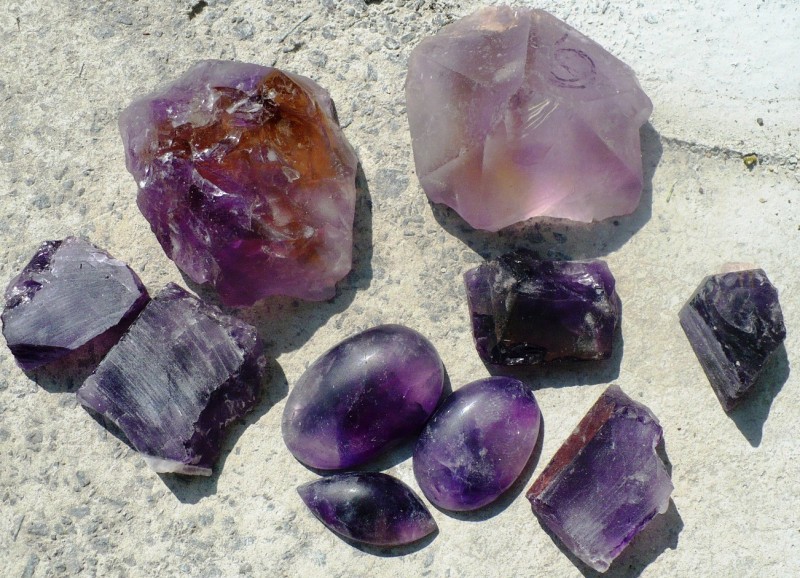
Slab = slice of stone of different thickness. Weaknesses are either being prepared by ourselves (which is the cheapest) or the raw material is already sold in them. The advantage is that we do not buy the hare in the bag. Which can easily happen with a lump of stone you don't see. (but it's an adventure again)
Weaknesses of Charmites and Chrysopals
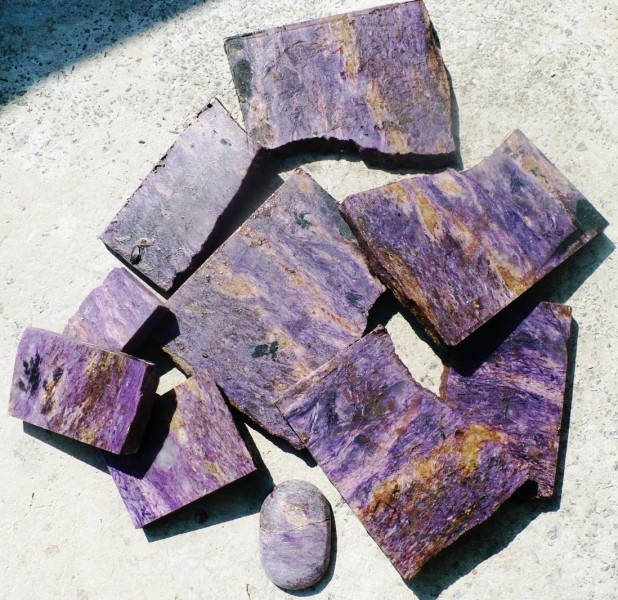
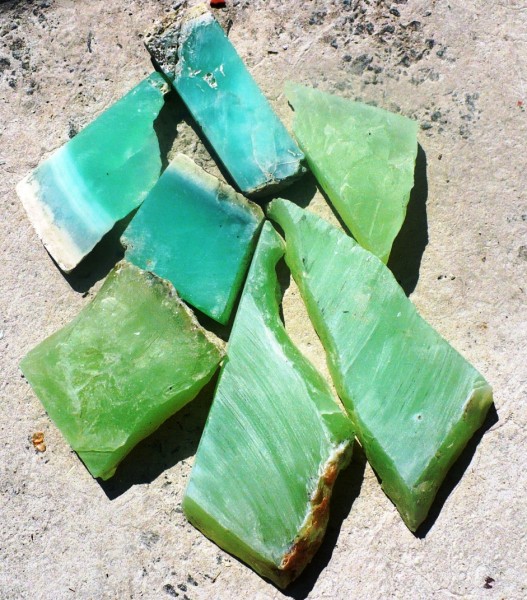
Long ago, we are not able to pick up the field, unfortunately there are no olives, no tourmalines, not even aquamarines on our fields, so the first step, if we want something great, is to go out into the world several times a year and choose what we will cut in. what quality and most importantly to grind ...
Raw material is never enough, so we have lecos in our warehouse. That we can satisfy what the customer's heart desires (that is, we try).Every time there is something else, or already, we don't have ... And because stones don't print, they must have at least the warehouse.



- Step, get a stone, we're behind, step 2 comes
- Cutting - ie cutting stone
If we have a lump (which is mostly), it has to be sliced (weak). It looks simple, but in fact it is the most complex and crucial process for the resulting stone. All fractures, cavities, caries and aesthetic sites must be taken into account. It requires experience and feeling. If the stone has an effect, then orient it properly, which is not as easy as it would be, it often changes during cutting (and of course, if it fails, the effect is in the grove and not on the stone). It is necessary to choose the appropriate thickness of the slices so that the grinding and cutting can withstand it at the same time, and at the same time that the resulting stone does not have a scale.
In the photo, you can see how the fine drops of water dotted the hairs on the hands

Who is afraid not to saw. The stone is held with both hands, it has to be a lot of pressure on it (especially if it is hard and tough like Moroccan agate). Water splashes all around, sparks fly, and of course it's not a quiet process, but anyway, when you finally see what's inside, it's just an experience.


Jééé, this is beautiful!

Cutting to the weak is over, step three
- Cutting For Shapes
Larger weaknesses still need to be cut into smaller pieces. Few would have a 15 cm cabochon, inviting a baby bib. Usually we take into account the drawing of the stone, and the cores and cracks, so our cabochons are different. In short, how it works. We cut the trimmings that cannot be grinded, and the tumblers, which do not look even a bit nice, are sprinkled on the path.
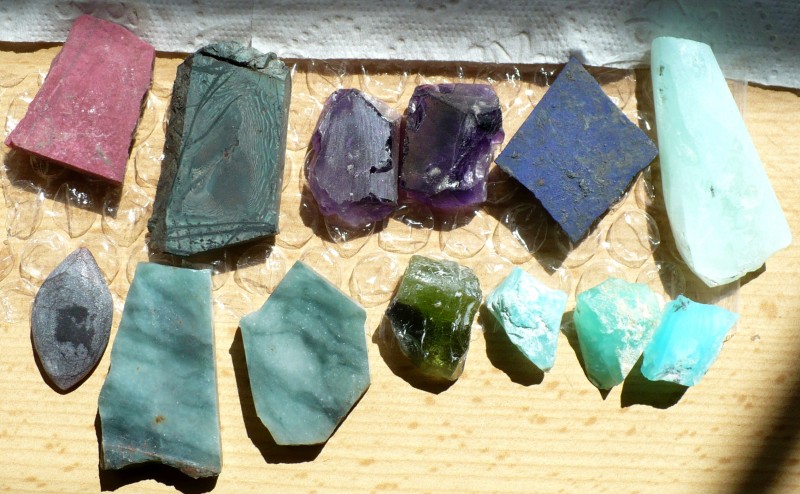
It's done like this: you make a cup of coffee, take a pencil, weak, and sit in the kitchen. You have a nice drawing of the weak ones, where it would be best to cut it, so that it would come out as beautiful as possible. Usually we sit over the more complicated two and debate.
Honza: I don't know here.
Me: here this piece has a nice drawing in this place, it would be a nice circle
Honza: But there is a crack through here, the wheel cannot be.
I: when this crack goes through, it's clear that we'll have to cut it there. Why are you asking?
Honza: But then what next?
I: That is clear. We get two pieces, one more half, and the other one bigger ... and this piece would be a lovely heart ...
Honza: But look from the other side
Me: Oh, nojo, if I cut it like that, we'll lose this beautiful blue piece… uh, I don't know… and so on and so on…
In the figure, the faintly prepared ones are ready for final cutting

- Self grinding
The stones are cut into small pieces, squares, rhombuses, rectangles and triangles and we can start grinding.
Grinding is already a job suitable for boys and girls, it is also fun, and the head is not burdening. The cutter must have a sense of shape, patience, and most importantly he must like stones. Without these assumptions, it would not be possible. The fact is that it cannot be done too long, after 4 hours it has hurt a lot of hands, especially if it is grinding and polishing harder stones. It's not a shuffle, it just has to crush.
Before you learn how to grind and polish in such a way that graceful curves will crawl on your armrests rather than lumps and crisps, it usually takes 2-3 months, but you learn all your life as you go, because each stone must be different. Some at a certain stage, when careless, sprinkle, others are difficult to polish, etc. It is therefore very experimental work.
Like cutting saws, grinding wheels are consumables that need to be bought and changed frequently.
Therefore, not only machines, stones, but also "maintenance matters" take up a significant amount of space. We work in the spirit of what one does not correct himself, or he does not. Most of the equipment is unfortunately a foreign provinience, (nothing in the Czech Republic is produced) andthe claim process makes no sense. It is always easier, faster and cheaper to solve it alone. For example, even if you order a machine for European standards, it does not mean that it does not come with an American, English or other plug that definitely does not fit into our outlet. These details do not fundamentally deal with the manufacturers. So we have to deal with it. Most machines are made for 1 year of life, so after one year you become a repairer. Spare parts from abroad are a chapter for themselves.
Toilet paper does not serve the grinders as it would be thought, but it is the most reliable "hand dryer, piece, and stone" It is much better where you leave it than the roll of paper towels. And this is quite essential in a workshop where it is still wet. :-D Even at least we don't have to look abroad.

when we deal with technical difficulties. And these often occur. We can devote ourselves to grinding.
Seven is said to be a magic number, and a stone must also go through seven grinding steps, that is, seven discs from coarsest to finest. At each step, the stone and the grinder spend a lot of time, but for a few minutes. The process cannot be cheated, because scraps would remain on the stone. Unfortunately, no hatch and in 5 minutes, there is no.
7 steps from wafer to cabochon
- Shaping on a coarse disc (the cutter outlines the shape of the stone, it has a lot of facets, scratches .. just rough work)
- Shaping on a medium coarse disc (the worst flats and grooves come together)
- Smooth shape on the finest of coarse discs
The next three steps are polishing (each step is checked for scratches, we are going back one step, which is practically every time)
- Fine sanding - remove sanding scratches
- Polishing even finer than the previous step
- Předlesk
- Gloss (the most lynchistic part of grinding) here are used different blades and different polishing media, what kind of stone do other behaviors, often behave differently the same types of stone from other locations! forgotten grooves. Then one goes back a few reels grooves repair again polishes, and it is! Believe not believe sometimes you return even 5x.
.jpg)

The final polishing and shaping of the plane is carried out on the side discs or on a planar disc when there is more. It is laborious, much of it hurts, but straight underpants are better placed in jewelry than rounded. (You can often see it on Indian cabochons). To avoid one finger, a special (also expensive) finger protection tape is used.
It is clear that in this way it is possible to grind the cabochons rather larger, in our country it means from 8mm, (and it requires a lot of practice) anything smaller, you do not hold in your hand, so we do not produce calibrated minicabs. These must be put on the bars and this is very time consuming. (in the world, semi-automatic machines are used for their production in large factories in China, India and Indonesia). Their production would be too expensive in our conditions, and the price too high, so we don't even try to do it.
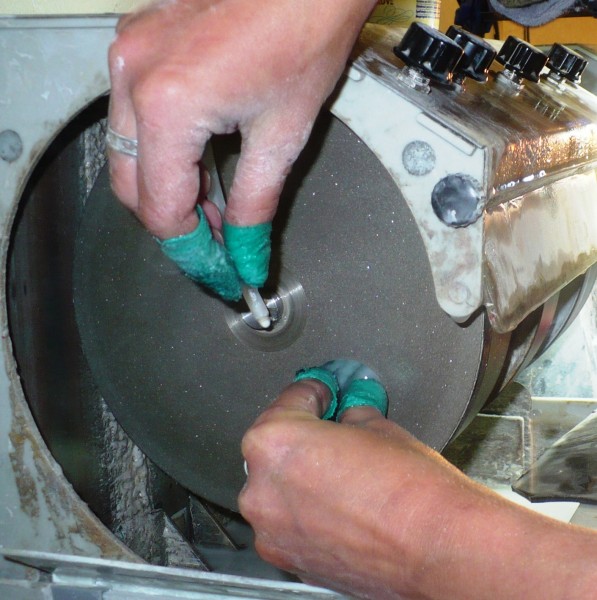

The slices to be shaped and the coarsely shaped future cabochons

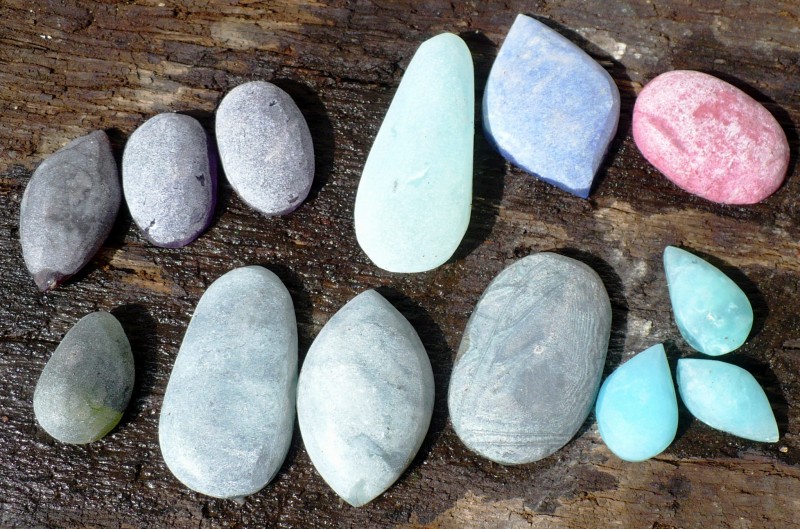
Coarse-shaped stones - detail; and stones in the next step - finer shaping
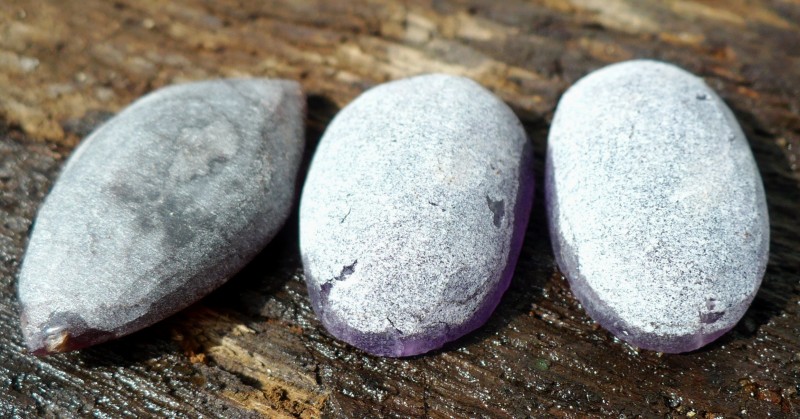
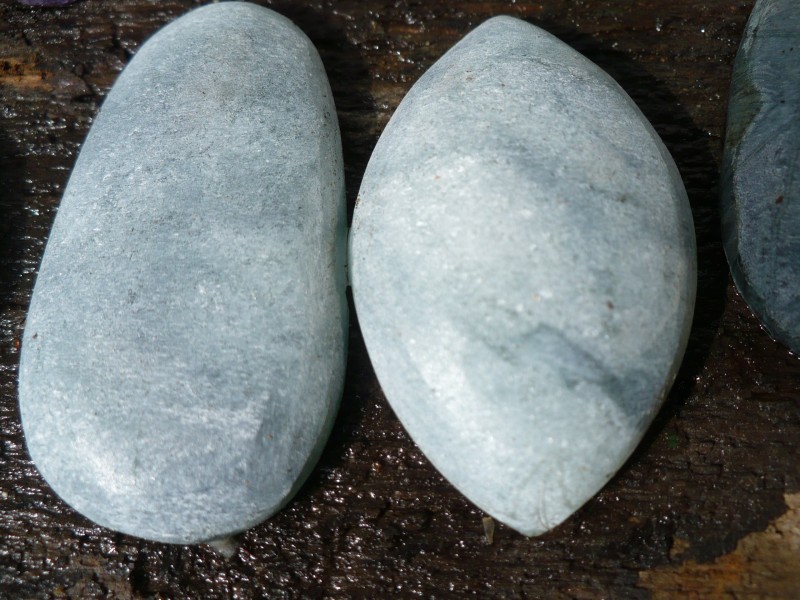
Garnets shaped and raw (Tanzania)
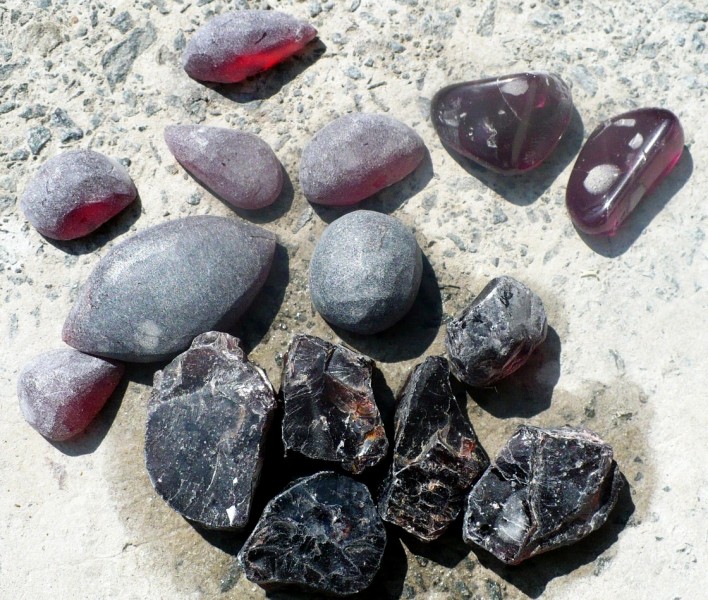
Serafinity at different stages, including "jewelry stage"
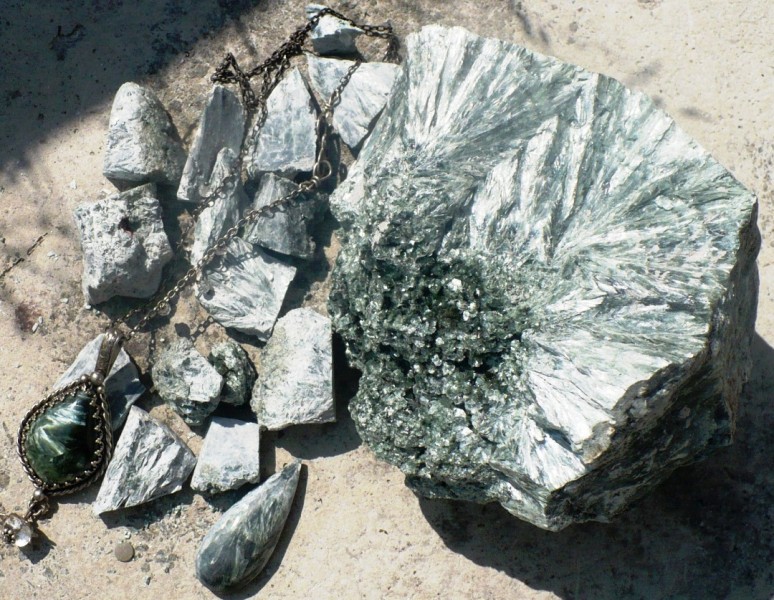
The results of our work then go to boxes and then to their new homes.
We sincerely thank all our customers for their favor, without which this foolish production would not be possible at all!
; height: 400px; "/>
Final Quiz - The question is: What was ready for cutting in the crate? (and then grinding and polishing)

a) Cacoxenite

b) silver lunar stone

c) Lapis lazuli - light

d) Glittering thulite

e) Oregon dendritic agate
.jpg)
f) Aurit in granite from mountain K2

g) Royal Jasper Morocco

(h) Amazonite Tanzania

i) The Pink Opal of Peru

(j) Serpentinite - Russia


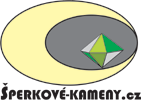

 (0) - 0,-
(0) - 0,-




